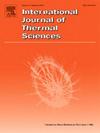Marangoni condensation of steam-ethanol mixture on wire-wrapped tube: effect of wire pitch on heat transfer augmentation
IF 4.9
2区 工程技术
Q1 ENGINEERING, MECHANICAL
International Journal of Thermal Sciences
Pub Date : 2025-04-09
DOI:10.1016/j.ijthermalsci.2025.109912
引用次数: 0
Abstract
This study investigates the Marangoni condensation of steam-ethanol mixtures on wire-wrapped tubes at atmospheric pressure, with a constant vapor velocity of 0.48 m/s. Experiments were conducted using various mass ethanol concentrations (0.0125 %, 0.05 %, 0.1 %, and 0.3 %) with a 0.5 mm copper wire diameter, and wire pitches of (1.6 mm, 2 mm, 2.4 mm, and 2.9 mm). Special precautions were taken to eliminate air from the vapor phase and minimize experimental errors. Visual observations revealed distinct condensation modes, transitioning from film-wise condensation for the case of pure steam into pseudo-dropwise condensation with the addition of ethanol. The presence of ethanol improved heat transfer by reducing the film thickness, forming small droplets between the wire windings. Additionally, the wire wrapping increased the surface area, sliced film thickness, and minimized retention, thereby expanding the active surface area and significantly enhancing heat transfer. Both factors were thoroughly investigated to understand their combined effects. The results demonstrate significant improvements in heat transfer performance compared to pure steam, with notable increases in heat flux and heat transfer coefficients. The most significant enhancement ratio, defined as the ratio of observed heat transfer values to those predicted by Nusselt's theory (1916), was 9.9, occurring at an ethanol concentration of 0.1 % and a pitch of 2.9 mm.
蒸汽-乙醇混合物在包丝管内的Marangoni冷凝:丝距对强化传热的影响
本文研究了常压下蒸汽-乙醇混合物在金属丝缠绕管上的Marangoni冷凝,蒸汽速度恒定为0.48 m/s。实验采用不同浓度的乙醇(0.0125%、0.05%、0.1%和0.3%),铜线直径0.5 mm,丝距1.6 mm、2mm、2.4 mm和2.9 mm。采取了特殊的预防措施,以消除气相中的空气,并尽量减少实验误差。目视观察揭示了不同的冷凝模式,从纯蒸汽的膜状冷凝过渡到添加乙醇的伪滴状冷凝。乙醇的存在通过减少薄膜厚度,在导线绕组之间形成小液滴来改善传热。此外,金属丝缠绕增加了表面面积,切片膜厚度,并最大限度地减少滞留,从而扩大了有效表面面积,显着增强了传热。我们对这两个因素进行了深入的研究,以了解它们的综合影响。结果表明,与纯蒸汽相比,其换热性能有了显著改善,热流密度和换热系数均有显著提高。最显著的增强比(定义为观察到的传热值与Nusselt理论(1916)预测的传热值之比)是9.9,发生在乙醇浓度为0.1%和间距为2.9 mm的情况下。
本文章由计算机程序翻译,如有差异,请以英文原文为准。
求助全文
约1分钟内获得全文
求助全文
来源期刊

International Journal of Thermal Sciences
工程技术-工程:机械
CiteScore
8.10
自引率
11.10%
发文量
531
审稿时长
55 days
期刊介绍:
The International Journal of Thermal Sciences is a journal devoted to the publication of fundamental studies on the physics of transfer processes in general, with an emphasis on thermal aspects and also applied research on various processes, energy systems and the environment. Articles are published in English and French, and are subject to peer review.
The fundamental subjects considered within the scope of the journal are:
* Heat and relevant mass transfer at all scales (nano, micro and macro) and in all types of material (heterogeneous, composites, biological,...) and fluid flow
* Forced, natural or mixed convection in reactive or non-reactive media
* Single or multi–phase fluid flow with or without phase change
* Near–and far–field radiative heat transfer
* Combined modes of heat transfer in complex systems (for example, plasmas, biological, geological,...)
* Multiscale modelling
The applied research topics include:
* Heat exchangers, heat pipes, cooling processes
* Transport phenomena taking place in industrial processes (chemical, food and agricultural, metallurgical, space and aeronautical, automobile industries)
* Nano–and micro–technology for energy, space, biosystems and devices
* Heat transport analysis in advanced systems
* Impact of energy–related processes on environment, and emerging energy systems
The study of thermophysical properties of materials and fluids, thermal measurement techniques, inverse methods, and the developments of experimental methods are within the scope of the International Journal of Thermal Sciences which also covers the modelling, and numerical methods applied to thermal transfer.
 求助内容:
求助内容: 应助结果提醒方式:
应助结果提醒方式:


